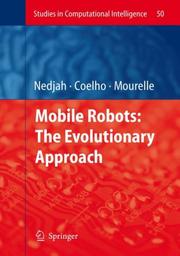| Listing 1 - 2 of 2 |
Sort by
|
Book
ISBN: 3642103022 9786612837333 3642103456 1282837338 Year: 2010 Publisher: Heidelberg ; London : Springer,
Abstract | Keywords | Export | Availability | Bookmark
 Loading...
Loading...Choose an application
- Reference Manager
- EndNote
- RefWorks (Direct export to RefWorks)
What is space? Is there space when there are objects to occupy it or is there space only when there are no objects to occupy it? Can there be space without objects? These are old philosophical questions that concern the ontology of space in the philosophical sense of ‘ontology’ – what is the nature of space? Cognitive science in general and arti?cial intelligence in particular are less c- cerned with the nature of things than with their mental conceptualizations. In spatial cognition research we address questions like What do we know about space? How is space represented? What are the representational entities? What are the rep- sentational structures? Answers to these questions are described in what is called ontologies in arti?cial intelligence. Different tasks require different knowledge, and different representations of knowledge facilitate different ways of solving problems. In this book, Jan Oliver Wallgrün develops and investigates representational structures to support tasks of autonomous mobile robots, from the acquisition of knowledge to the use of this knowledge for navigation. The research presented is concerned with the robot mapping problem, the pr- lem of building a spatial representation of an environment that is perceived by s- sors that only provide incomplete and uncertain information; this information usually needs to be related to other imprecise or uncertain information. The routes a robot can take can be abstractly described in terms of graphs where alternative routes are represented by alternative branches in these route graphs.
Engineering. --- Mobile robots -- Programming. --- Spatial data infrastructures. --- Voronoi polygons. --- Robots --- Mobile robots --- Voronoi polygons --- Spatial data infrastructures --- Mechanical Engineering --- Mechanical Engineering - General --- Engineering & Applied Sciences --- Dynamics --- Programming --- Programming. --- Diagrams, Voronoi --- Thiessen polygon method --- Thiessen polygons --- Voronoi diagrams --- SDIs (Geographic information systems) --- Artificial intelligence. --- Robotics. --- Automation. --- Robotics and Automation. --- Artificial Intelligence (incl. Robotics). --- Geographic information systems --- Polygons

ISBN: 9783540497196 3540497196 9786610853038 1280853034 354049720X Year: 2007 Publisher: Berlin, Heidelberg : Springer,
Abstract | Keywords | Export | Availability | Bookmark
 Loading...
Loading...Choose an application
- Reference Manager
- EndNote
- RefWorks (Direct export to RefWorks)
The design and control of autonomous intelligent mobile robotic systems operating in unstructured changing environments includes many objective difficulties. There are several studies about the ways in which, robots exhibiting some degree of autonomy, adapt themselves to fit in their environments. The application and use of bio-inspired and intelligent techniques such as reinforcement learning, artificial neural networks, evolutionary computation and so forth in the design and improvement of robot designs is an emergent research topic. Researchers have obtained robots that display an amazing slew of behaviours and perform a multitude of tasks. These include perception of environment, planning and navigation in rough terrain, pushing boxes, negotiating an obstacle course, etc. In this context, mobile robots designed using evolutionary computation approaches, usually known as Mobile Evolutionary Robotics, have experienced significant development in the last decade. The fundamental goal of mobile evolutionary robotics is to apply evolutionary computation methods to automate the production of complex behavioural robotic controllers. This volume offers a wide spectrum of sample works developed in leading research throughout the world about evolutionary mobile robotics and demonstrates the success of the technique in evolving efficient and capable mobile robots.
Mobile robots --- Autonomous robots --- Evolutionary programming (Computer science) --- Artificial intelligence. --- Programmation évolutive --- Intelligence artificielle --- Programming. --- Autonomous robots -- Programming. --- Electronic books. -- local. --- Evolutionary programming (Computer science). --- Mobile robots -- Programming. --- Mechanical Engineering --- Civil & Environmental Engineering --- Engineering & Applied Sciences --- Applied Mathematics --- Civil Engineering --- Mechanical Engineering - General --- AI (Artificial intelligence) --- Artificial thinking --- Electronic brains --- Intellectronics --- Intelligence, Artificial --- Intelligent machines --- Machine intelligence --- Thinking, Artificial --- Autonomous robotic systems --- Engineering. --- Applied mathematics. --- Engineering mathematics. --- Appl.Mathematics/Computational Methods of Engineering. --- Artificial Intelligence (incl. Robotics). --- Bionics --- Cognitive science --- Digital computer simulation --- Electronic data processing --- Logic machines --- Machine theory --- Self-organizing systems --- Simulation methods --- Fifth generation computers --- Neural computers --- Engineering --- Engineering analysis --- Mathematical analysis --- Construction --- Industrial arts --- Technology --- Mathematics --- Computer programming --- Robots --- Mathematical and Computational Engineering. --- Artificial Intelligence.
| Listing 1 - 2 of 2 |
Sort by
|

 Search
Search Feedback
Feedback About UniCat
About UniCat  Help
Help News
News